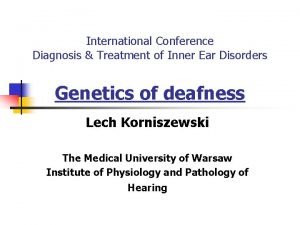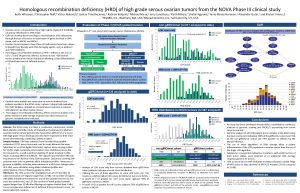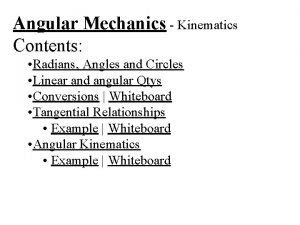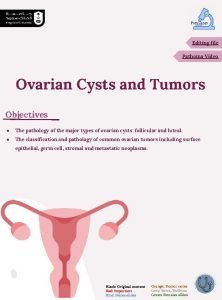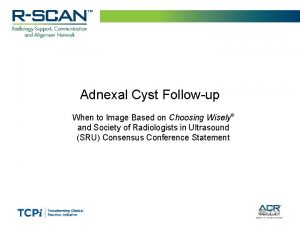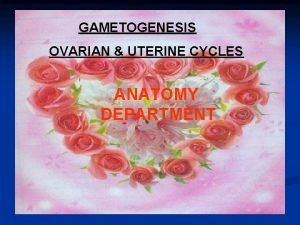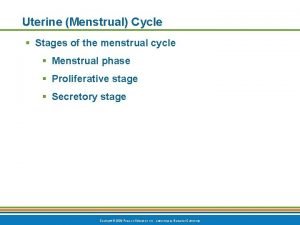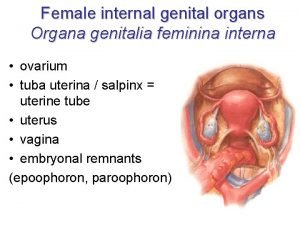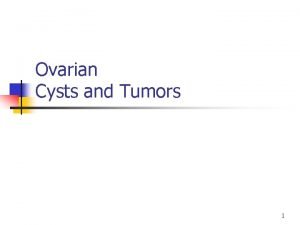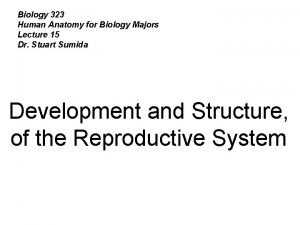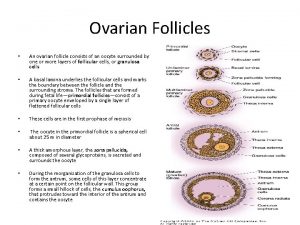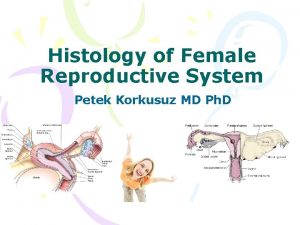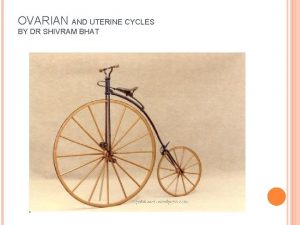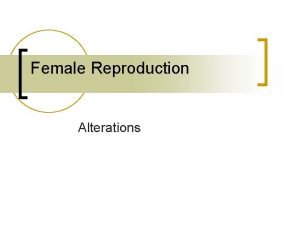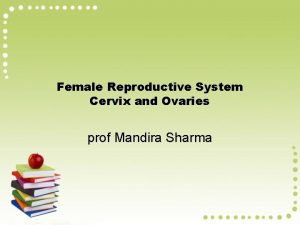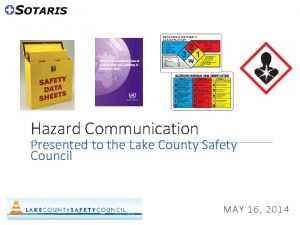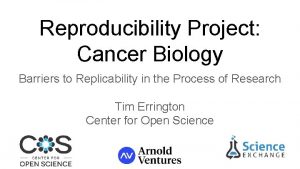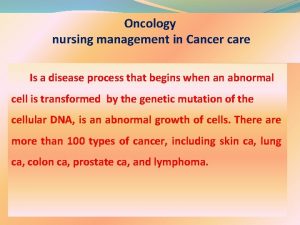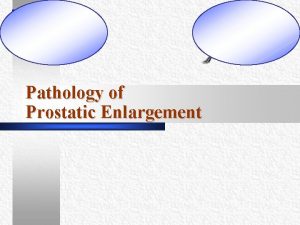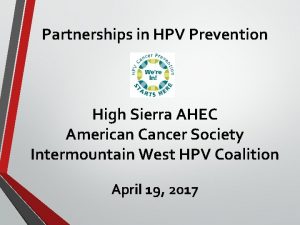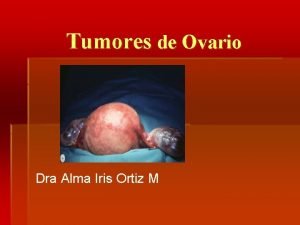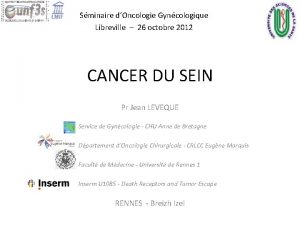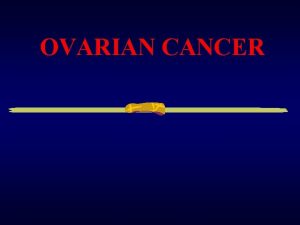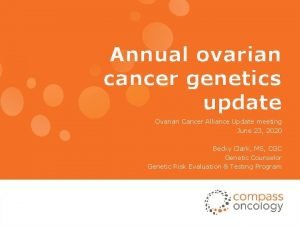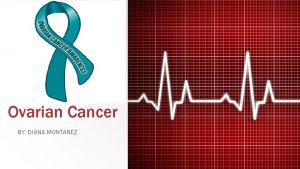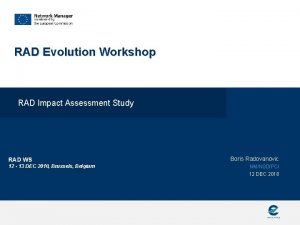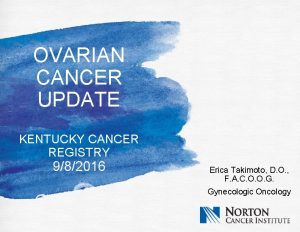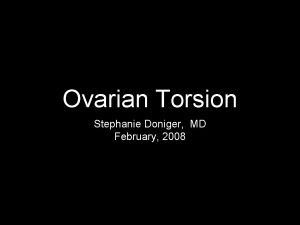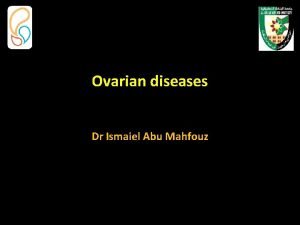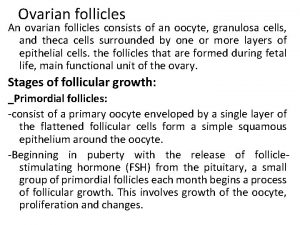Ovarian Cancer RAD 51 D What is Ovarian








































- Slides: 40

Ovarian Cancer RAD 51 D

What is Ovarian Cancer?

What are Symptoms of Ovarian Cancer?

What are the different Cells of the Ovaries? Protects Ovary Produces Steroid Hormones Produces Egg Cells

What is the Role of RAD 51 D? 2 KZ 3|A ss. DNA Binding Cellular Component RAD 51/AAA BRC Repeats 328 C-terminus DNA Binding/ATPase Molecular Function Biological Processes

What is the Evolutionary History of RAD 51 D? © 2006 by National Academ of Sciences

What’s RAD 51 D’s Role in Homology Repair? Exonuclease RPA RAD 51

Is the RAD 51 Domain Conserved Across Species?

Model Organism 1: Mus musculus Similar Physiology to Humans -Can supplement hormones in Feed Genetic Engineering Tools -Ovarian Specific Expression Similar Ovarian Microenvironment Xenografting Tools -Ovarian Tumor Mode

Model Organism 2: Danio rerio Steroid Hormone Receptors Cheap and Fast Genetic Screens Xenografting Tools -Ovarian Tumor Model Good For Fluorescent Microscopy

RAD 51 D is a Part of the BCDX 2 Complex Mouse Human

Why Do RAD 51 D Mutations Have Tissue Specific Phenotypes? “Large-scale meta-analysis of mutations identified in panels of breast/ovarian cancer-related genes — Providing evidence of cancer predisposition genes” • Profiles of genes contributing to breast and ovarian cancer differ substantially. • RAD 51 C, RAD 51 D, and BRIP 1 are proved to be high-risk ovarian, but not breast cancer genes. Vs.

Can the Microenvironment of the Ovary Explain the Phenotype?

How Does Estrogen Cause DNA Damage?

How Does Estrogen Cause DNA Damage?

How Does Estrogen Cause DNA Damage?

What About RAD 51 -Independent Repair? SSA NHEJ

What About RAD 51 -Independent Repair? SSA

What About RAD 51 -Independent Repair? ?

What About RAD 51 -Independent Repair? ?

What About RAD 51 -Independent Repair? SLIDE WITH FIGURES NOT USED

What is the Primary Goal? To better understand how the microenvironment of the ovaries and RAD 51 D interact to influence DNA Repair Aim 1: Aim 2: Characterize conserved domains and motifs in RAD 51 D that are crucial for ovarian integrity. Identify small molecules that alter ovarian genomic stability in both WT and mutant RAD 51 D Aim 3: Identify the role of putative Phosphorylation Sites on the RAD 51 D Protein

Aim 1: Characterize Conserved Domains Essential for Ovarian Integrity Clustal W Identify Homologs Using Blastp Cre - Loxp Quantify Repair Compare RAD 51 D in vertebrate ovaries vs. non-vertebrates

Aim 1: Characterize Conserved Domains Essential for Ovarian Integrity Clustal W Cre - Loxp Quantify Repair

Aim 1: Characterize Conserved Domains Essential for Ovarian Integrity Clustal W Cre - Loxp Quantify Repair May NOT USE

Aim 1: Characterize Conserved Domains Essential for Ovarian Integrity Clustal W ovarian p Quantify Repair Cre - Loxp n. P CRE Lox. P RAD 51 D Gene Lox. P

Aim 1: Characterize Conserved Domains Essential for Ovarian Integrity Clustal W Cre - Loxp Assess DNA Repair Quantify tumorigenesis in the ovaries

Aim 1: Characterize Conserved Domains Essential for Ovarian Integrity Clustal W Cre - Loxp Assess DNA Repair

Aim 1: Characterize Conserved Domains Essential for Ovarian Integrity Clustal W WT Cre - Loxp Assess DNA Repair Mutant A: no ss. DNA Binding Mutant B: No BCDX 2 Binding?

Aim 1: Characterize Conserved Domains Essential for Ovarian Integrity Clustal W WT Cre - Loxp Assess DNA Repair Mutant A: no ss. DNA Binding Mutant B: No BCDX 2 Binding?

Aim 2: Identify small molecules that affect ovarian genetic integrity Chemical Genomic Screen Assess DNA Repair

Aim 2: Identify small molecules that affect ovarian genetic integrity Chemical Genomic Screen Assess DNA Repair

Aim 2: Identify small molecules that affect ovarian genetic integrity Chemical Genomic Screen Assess DNA Repair

Aim 3: Identify the Role of RAD 51 D PTM and DNA Repair Clustal W Proteomic Tools CRISPR-Cas-9 Mice Knock-in Assess DNA Repair

Aim 3: Identify the Role of RAD 51 D PTM and DNA Repair Clustal W Proteomic Tools CRISPR-Cas-9 Mice Knock-in Assess DNA Repair

Aim 3: Identify the Role of RAD 51 D PTM and DNA Repair Clustal W Proteomic Tools Will Create a better Figure for CRISPR-Cas-9 Zebrafish Knockin Assess DNA Repair

Aim 3: Identify the Role of RAD 51 D PTM and DNA Repair Clustal W Proteomic Tools CRISPR-Cas-9 Mice Knock-in Assess DNA Repair

Summary Identify Conserved Amino Acids that are important for Ovarian integrity Identify Hormones and Small Molecules that alter DNA repair in ovarian cells Identify the role of uncharacterized PTM in RAD 51 D and its affect on DNA Repair

References 1. Ovarian Tumor: https: //tat. gu. se/digital. Assets/1331718_tum--r. jpg 2. Ovary Image: https: //universityhealthnews. com/daily/cancer/respond-quickly-to-ovarian-cancer-symptoms/ 3. Symptoms: https: //www. verywellhealth. com/ovarian-cancer-causes-risk-factors-2509671 4. Cell Types: https: //obgynkey. com/chapter-36 -ovarian-germ-cell-and-sex-cord-stromal-tumors/ 5. Biorender: https: //biorender. com/ , DNA Binding: https: //en. wikipedia. org/wiki/DNA-binding_protein 6. Rad 51 Family: https: //www. pnas. org/content/103/27/10328 7. Biorender: https: //biorender. com/ 9 -10. Biorender: https: //biorender. com/ 11. Biorender: https: //biorender. com/ , STRING: https: //string-db. org/cgi/network. pl 7 -11. Biorender: https: //biorender. com/ 12. Biorender: https: //biorender. com/ 13. Ovarian Figure: https: //doi. org/10. 1093/carcin/bgi 136 14 -21. Biorender: https: //biorender. com/ 22. Double Stand Break Cartoon: https: //innovativegenomics. org/resources/educational-materials/glossary/double-strand-break/ 23. Blastp: https: //blast. ncbi. nlm. nih. gov/Blast. cgi, MEGA: https: //www. megasoftware. net/ 24. MEGA: https: //www. megasoftware. net/ 25. Clustal Omega: https: //www. ebi. ac. uk/Tools/msa/clustalo/ 26. Biorender: https: //biorender. com/ 27. Biorender: https: //biorender. com/ 28. TLR: https: //www. researchgate. net/publication/257754595_Novel_fluorescent_genome_editing_reporters_for_monitoring_DNA_repair_pathway_utilization_at_endonucleaseinduced_breaks 29. Traffic Light: https: //i. pinimg. com/originals/28/ff/6 f/28 ff 6 f 46 d 418860 eacb 64 f 4 d 62 a 86 a 96. jpg 30. Traffic Light: https: //i. pinimg. com/originals/28/ff/6 f/28 ff 6 f 46 d 418860 eacb 64 f 4 d 62 a 86 a 96. jpg 31. Biorender: https: //biorender. com/ 32. Biorender: https: //biorender. com/ , Traffic Light: https: //i. pinimg. com/originals/28/ff/6 f/28 ff 6 f 46 d 418860 eacb 64 f 4 d 62 a 86 a 96. jpg 33. Biorender: https: //biorender. com/ 34. Phosphosite: https: //www. phosite. org/protein. Action? id=9321&show. All. Sites=true 35. Phosphosite: https: //www. phosite. org/protein. Action? id=9321&show. All. Sites=true

References 35. Crispr: https: //www. addgene. org/crispr/guide/ 36. Traffic Light: https: //i. pinimg. com/originals/28/ff/6 f/28 ff 6 f 46 d 418860 eacb 64 f 4 d 62 a 86 a 96. jpg
 Ovarian cancer causes
Ovarian cancer causes Ovarian cancer brca
Ovarian cancer brca Hrd score ovarian cancer
Hrd score ovarian cancer Ovarian cancer marker
Ovarian cancer marker Rad/s
Rad/s Ovarian cyst size chart
Ovarian cyst size chart Sru consensus ovarian cysts
Sru consensus ovarian cysts Ducts in female reproductive system
Ducts in female reproductive system Ovarian follicle
Ovarian follicle Spermiogenesis
Spermiogenesis Ovarian cycle
Ovarian cycle Ovary functions
Ovary functions Benjamin cummings
Benjamin cummings Portio vaginalis
Portio vaginalis Ovarian ligament
Ovarian ligament Ovarian teratoma
Ovarian teratoma Ovarian ligament
Ovarian ligament Infundibulum female reproductive system
Infundibulum female reproductive system The ovarian cycle
The ovarian cycle Ovarian follicle
Ovarian follicle Female external genitalia histology
Female external genitalia histology Corona radiata
Corona radiata Ovarian benign tumor
Ovarian benign tumor Ovarian cyst about to rupture
Ovarian cyst about to rupture Chapter 16 the reproductive system
Chapter 16 the reproductive system Immature teratoma
Immature teratoma May cause cancer pictogram
May cause cancer pictogram Hospital max peralta extensiones
Hospital max peralta extensiones Reproducibility project cancer biology
Reproducibility project cancer biology Cancer
Cancer What is cancer
What is cancer Excessive belching cancer
Excessive belching cancer Suspected cancer recognition and referral
Suspected cancer recognition and referral Diaphrosis
Diaphrosis Tobacco causes cancer
Tobacco causes cancer Prostate cancer tnm classification
Prostate cancer tnm classification Signs of breast cancer
Signs of breast cancer Cancer metastasis
Cancer metastasis High sierra ahec
High sierra ahec Ginandroblastoma
Ginandroblastoma Crete fibro glandulaire de duret
Crete fibro glandulaire de duret

